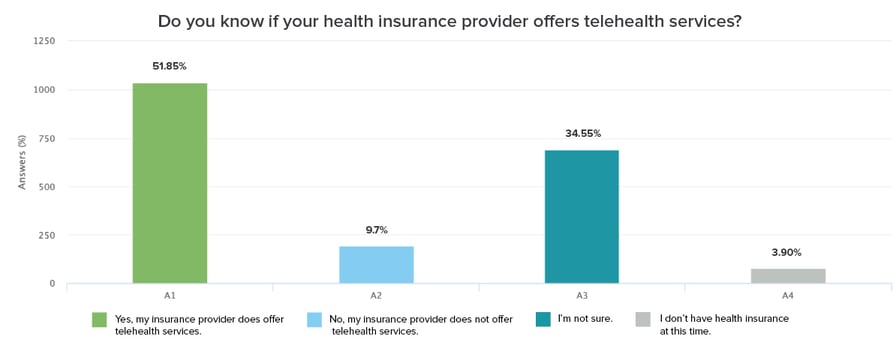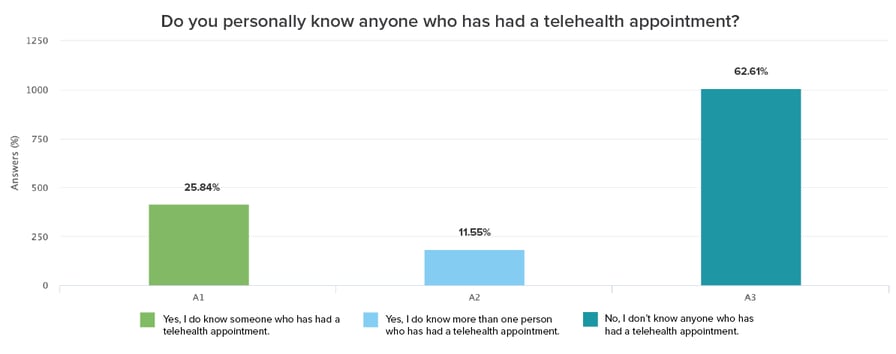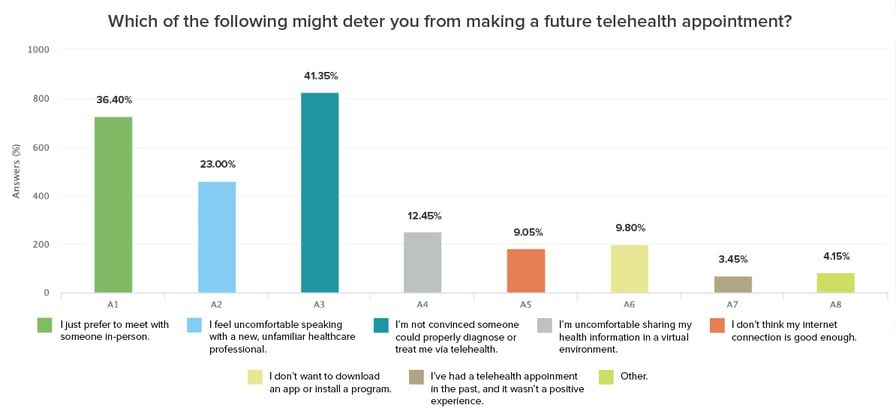A survey of 2,000 adults across the U.S. on perceptions of telehealth during COVID-19 found that more than 95% of respondents who had used telehealth said they already have or would consider scheduling another telehealth appointment in the future. The most cited advantages to telehealth were quicker and greater access to care and avoiding overcrowded wait rooms.
SURVEY REPORT: Americans’ Perceptions of Telehealth in the Era of COVID-19
Telehealth technology, while originally designed to give access to care in areas where there is a shortage of specialty care providers, is now being examined as a way to screen and diagnose patients without risking the spread of disease through personal contact. However, use of telehealth has historically been challenged by a variety of factors, including cost of the equipment, inconsistent regulation across geographies, reimbursement issues, patient access to high-speed internet and biases toward having in-person visits to physicians.
But, with increased reporting of a surge of telehealth visits and a boost in mental health app usage in the midst of a global pandemic, we wanted to better understand how people all over the U.S. perceive virtual health care, what they’re hopeful about and what they’re skeptical about, in this new era of COVID-19.
We surveyed 2,000 adults from around the United States between March 19-20, 2020 via Pollfish, a third-party consumer-focused survey platform, in order to assess their perceptions of and experiences with telehealth.
Poll respondents were equally distributed across the country, with 500 respondents each from the Midwest, the Northeast, the South and the West. We provided potential respondents with an initial telehealth definition and focused our attention on those who indicated a familiarity with telehealth. Of note — 1,441 potential respondents (nearly 42 percent of everyone who completed the screening question) indicated that they were not familiar with telehealth; those respondents were not qualified to complete the survey.
What follows are the results of our 13-question survey on exposure to telehealth.
1. Do you know if your health insurance provider offers telehealth services?
The majority of those surveyed indicated they were aware that their health insurance plan covered telehealth services, a vital contributor to many people’s willingness to utilize any specific health service. In contrast, nearly 35 percent of respondents were unsure whether telehealth is covered by their health insurance provider, and less than 10 percent saying that their insurance did not offer coverage.
Of the more than one-third of respondents who did not know if their insurance covered telehealth, more than 25 percent were over the age of 55. People in the upper range of this age group — especially those covered by Medicare — often face the most restrictions on utilization. However, the government continues to expand telehealth access.

2. Do you feel like you have been adequately informed on how to use telehealth services?
With the growing advent of additional types of virtual care and health monitoring, including new approaches — such as wearable technologies that can monitor a person’s health — the vast majority of those surveyed feel they understand how to use telehealth services. Of those with telehealth access through their insurance provider, a resounding 73 percent feel they have been adequately informed on how to use telehealth services. For the first two questions of our survey, respondents in the western U.S. were generally more aware of their coverage and how to access their telehealth benefit — 27 percent and 27.5 percent, respectively.

3. Have you ever considered trying a telehealth appointment?
While the majority of respondents note they are aware of telehealth, far fewer have actually tried a telehealth visit – only about 19 percent. Of that group, fully one-quarter fell within the 25-34 age group. Conversely, of the group that said they would never consider telehealth, nearly one-third were ages 55+ and older.
While older Americans’ usage of technology continues to increase, some suggest that confidence levels by seniors in usage of laptops, smartphones or wearable devices could be contributing to lack of use.

4. Would you consider scheduling another telehealth appointment in the future?
According to our survey data, an overwhelming amount of those who have tried telehealth services stated they were satisfied enough with the experience that they either already have or will consider scheduling another one in the future. Nearly two-thirds of those who have already had a telehealth appointment have had more than one.
In their first survey on the topic in 2019, J.D. Power found satisfaction levels with telehealth services to be higher than other segments of health care, as well as other service industries. The study cited the lack of barriers to enrollment and usage of the technology, and the ability to resolve their question during the telehealth visit as being key contributors.

5. Do you personally know anyone who has had a telehealth appointment?
While our survey results show a high percentage of respondents either have had a telehealth visit or would consider it, 62 percent of those who have never had a telehealth appointment also said they do not know anyone who has had one.

6. Besides availability and affordability, which of the following would most lead you to make a future telehealth appointment?
It is difficult to assess how much our current shelter-in-place orders and social distancing played into the top reason those surveyed would consider making a future appointment. However, 38 percent of all respondents like the idea of being able to get a potential diagnosis without being around others who are sick in a waiting room.
The convenience of a telehealth visit is similarly attractive to those surveyed; 36 percent prefer the potential of keeping an appointment without having to commute to a clinic or physician’s office. An additional 12 percent find the ability to schedule same-day care appealing.

7. Which of the following might deter you from making a future telehealth appointment?
Skepticism around quality of care and aspects of the patient-physician relationship were key motivators for those who would not consider a future telehealth visit. Over 40 percent of respondents were concerned about the ability to get proper treatment or a diagnosis in a virtual setting. One person commented: “My only concern would be the simple touch and feel aspect. If needed, the doctor obviously cannot [touch and feel] via the internet.” Other respondents expressed that they feel telehealth is only good for minor issues and illnesses.
The doctor-patient relationship has long been established as having a positive impact on health. For many in our survey, this is a key contributor to deciding to utilize telehealth services. To this point, 36 percent of respondents prefer a face-to-face engagement with their caregiver, one saying: “If I’m sick I want to see my doctor and get lab work to confirm my diagnosis…” Another 23 percent (a majority in the 18-24 age group) are uncomfortable speaking with who would likely be a new and unfamiliar practitioner.

8. What do you view as the main advantage to telehealth services?
Similar themes play out when asked the main advantages to telehealth. “Quicker access to care” was cited as the primary benefit — mostly by those in the 18-24 age group — followed by the ability to avoid overcrowded waiting rooms — most often cited by those in the 55+ age group.

9. Does anything in particular concern you about telehealth services?
Accuracy and quality of care were virtually equal responses when queried about concerns surrounding telehealth services. Respondents in the 55+ age group, as well as those from the Midwest, most frequently responded: “I’m not convinced a telehealth diagnosis can ever be truly accurate.”
A similar percentage of respondents selected: “I worry about the quality of health care,” highlighted by the numerous elaborated concerns of misdiagnosis due to problems with communication, either because of technical issues or because of misinterpretation by the clinician.

10. Do you feel that people get comparable health care through telehealth as they do for in-person visits?
When asked if people get comparable health care through telehealth as they do for in-person visits, about one-third of respondents say that they don’t believe it’s possible for comparable telehealth care — but that it’s a good option for initial consultations or basic care. On the other hand, roughly one-third of respondents say that they do believe people get comparable health care through telehealth.
Of those who believe people get comparable health care through telehealth, most are within the 18-24 age group, and most live in the western U.S. Those in the West were also the largest regional group to say they have been adequately informed on how to use telehealth services (Q2).
Of those who believe telehealth care will never match the quality of an in-person visit — older respondents most believe this, in the order of the 55+ age group most agreeing with this, followed by the 45-54 age group, followed by the 35-44 age group.

11. Telehealth services are being used to remotely screen patients for the Coronavirus Disease (COVID-19). If you showed symptoms for COVID-19, would you consider using a telehealth service if it were available and affordable to you?
When asked if respondents would consider using a telehealth service to be remotely screened for COVID-19 if it were available and affordable, nearly three-fourths said: “Yes, I would consider using a telehealth service if I felt I had COVID-19 symptoms.” It is conceivable that these numbers will continue to rise as the number of new COVID-19 cases increase. Interestingly, despite variations by age group in other questions, those saying “Yes” were evenly dispersed among all surveyed age groups.
At the time of this survey, more than one-in-ten respondents say they’ve already used a telehealth service for something related to COVID-19 — most commonly among the 18-24 age group, followed by the 25-34 age group.

12. Has the COVID-19 pandemic increased your willingness to try telehealth in the future?
Two-thirds of respondents say that COVID-19 has increased their willingness to try telehealth in the future. Fully one-quarter of respondents had not considered this as an option before.
More than 15 percent of respondents still report that COVID-19 had not increased their use of telehealth. Most of that group fell within the 35-45 age group, and were predominately in the southern U.S.

13. Do you know anyone who has used telehealth services this year to be screened for COVID-19?
Only a small percentage of respondents knew someone who had used telehealth to be screened for COVID-19, primarily in the 25-34 and 18-24 age groups.
